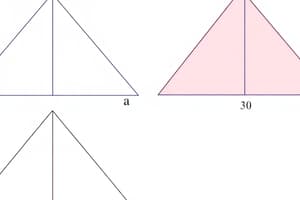Podcast
Questions and Answers
What measuring tool is most popularly used for measuring sizes and distances?
What measuring tool is most popularly used for measuring sizes and distances?
- French curve
- Standard ruler (correct)
- Metric ruler
- Triangular scale
In a triangular metric scale, how many millimeters are there in a centimeter?
In a triangular metric scale, how many millimeters are there in a centimeter?
- 12 millimeters
- 10 millimeters (correct)
- 5 millimeters
- 8 millimeters
To set off 80mm full size on the 1:1 scale, where do you begin measuring?
To set off 80mm full size on the 1:1 scale, where do you begin measuring?
- At the 5 cm mark
- At the end of the scale
- At the zero end of the 1:1 scale (correct)
- At the 10 cm mark
What is the purpose of drawing templates?
What is the purpose of drawing templates?
What is the primary function of the metric scale mentioned?
What is the primary function of the metric scale mentioned?
What is the primary function of a compass in drawing?
What is the primary function of a compass in drawing?
Which of the following statements about a protractor is correct?
Which of the following statements about a protractor is correct?
What distinguishes a scale from a ruler in technical drawing?
What distinguishes a scale from a ruler in technical drawing?
What type of triangle is commonly associated with 30°–60° angles?
What type of triangle is commonly associated with 30°–60° angles?
Which tool is best for transferring measurements accurately in drafting?
Which tool is best for transferring measurements accurately in drafting?
Flashcards are hidden until you start studying
Study Notes
Common Triangles in Geometry
- Right triangle with angles of 45°–45° and a 30°–60° triangle with angles of 30° and 60°.
- Key dimensions for the 30°–60° triangle include 30° and 60° angles.
Drawing Instruments
- Compass: Used for drawing arcs and circles; has a pen leg and a needle point leg.
- Divider: Transfers measurements and divides lines and arcs.
- Protractor: Semi-circular tool for measuring angles, divided into 180 degrees, typically made of plastic.
- Scales: Instruments for drawing to scale; includes metric, engineering, mechanical, decimal, and architect’s scales. Most commonly used is the architect's scale.
Triangular Metric Scale
- Full-size metric scale has major units for centimeters and minor units for millimeters; 10 millimeters make 1 centimeter.
- 1:1 scale used for 80mm measurement; 1:5 scale gives 4500mm at the 4.5 mark.
Rulers and Drawing Templates
- Ruler: Common measuring tool, typically 12 inches long, used for sizes and distances.
- Drawing Templates: Facilitate the creation of precise shapes without manual measuring tools.
Irregular Curves and French Curves
- Irregular curves/templates help create smooth lines; French curves were used for manual drafting before CAD tools became prevalent.
Cleaning Instruments
- Duster/Brush: Used for cleaning tools and removing eraser debris from drawing sheets.
Drafting Materials
- Drawing Paper: Hard and soft surface papers recommended; size considerations important for displaying elements without crowding.
- Tracing Paper and Oslo Paper: Frequently used in drafting; bond paper also recommended.
Plotters and Printers
- Plotters are key in engineering and architecture for large-scale technical drawings; multifunction printers now widely employed for various sizes.
Proper Use and Maintenance of Tools
- Importance of demonstrating proper use of measuring instruments.
- Regular maintenance essential for accuracy and longevity.
- Recognize common wear and issues affecting instrument performance.
Drafting Pencils and Pens
- Correct sharpening techniques are crucial for efficient use.
Alphabet of Lines
- The graphic alphabet includes various line symbols for clarity in drawings, utilizing thick and thin line widths for contrast.
Techniques for Drawing Lines
- Horizontal Lines: Use T-square for guidance; maintain pressure and angle for precision. Ensure visibility and avoid smudges during the process.
Studying That Suits You
Use AI to generate personalized quizzes and flashcards to suit your learning preferences.




